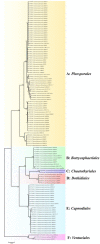Isolation and molecular characterization of clinical and environmental dematiaceous fungi and relatives from Iran
- PMID: 35528626
- PMCID: PMC9006730
- DOI: 10.18502/cmm.7.3.7798
Isolation and molecular characterization of clinical and environmental dematiaceous fungi and relatives from Iran
Abstract
Background and purpose: The frequency and genetic diversity of black fungi in environmental and clinical settings have not been fully studied in Iran. This study aimed to identify and evaluate intra- and inter-species DNA sequence variation and also understand the phylogenetic relationships of melanized fungi and relatives isolated from different geographical regions of Iran.
Materials and methods: In total, 111 clinical and environmental strains of dematiaceous fungi were isolated, and their internal transcribed spacer ribosomal DNA (rDNA) regions were sequenced and analyzed.
Results: An inter-species nucleotide sequence diversity rate of 1 to 464 nucleotides was observed between the species. Intra-species differences were found in the strains of Alternaria alternata, Cladosporium cladosporioides, Alternaria tenuissima, Curvularia spicifera, Aureobasidium pullulans, Curvularia hawaiiensis, Neoscytalidium dimidiatum, Alternaria terricola, Alternaria chlamydospora, Didymella glomerata, and Drechslera dematioidea by 0-59, 0-22, 0-4, 0-4, 0-3, 0-2, 0-2, 0-2, 0-2, 0-1, and 0-1 nucleotide, respectively.
Conclusion: The internal transcribed spacer rDNA is useful for the discrimination of several taxa of dematiaceous fungi. However, a better understanding of the taxonomy of species of Alternaria requires a larger rDNA region or a library of other gene sequences.
Keywords: Dematiaceous fungi; ITS rDNA region; Iran; Molecular identification.
Copyright: © Current Medical Mycology.
Figures

Similar articles
-
Diversity of culturable fungi inhabiting petroleum-contaminated soils in Southern Iran.Antonie Van Leeuwenhoek. 2017 Jul;110(7):903-923. doi: 10.1007/s10482-017-0863-1. Epub 2017 Mar 28. Antonie Van Leeuwenhoek. 2017. PMID: 28353091
-
Molecular characterization of environmental Cladosporium species isolated from Iran.Curr Med Mycol. 2017 Mar;3(1):1-5. doi: 10.18869/acadpub.cmm.3.1.1. Curr Med Mycol. 2017. PMID: 29302623 Free PMC article.
-
Oligo-DNA custom macroarray for monitoring major pathogenic and non-pathogenic fungi and bacteria in the phyllosphere of apple trees.PLoS One. 2012;7(3):e34249. doi: 10.1371/journal.pone.0034249. Epub 2012 Mar 30. PLoS One. 2012. PMID: 22479577 Free PMC article.
-
Epidemiology, clinical manifestations, and therapy of infections caused by dematiaceous fungi.J Chemother. 2003 Nov;15 Suppl 2:36-47. doi: 10.1179/joc.2003.15.Supplement-2.36. J Chemother. 2003. PMID: 14708965 Review.
-
Emerging Dematiaceous and Hyaline Fungi Causing Keratitis in a Tertiary Care Centre From North India.Cornea. 2020 Jul;39(7):868-876. doi: 10.1097/ICO.0000000000002295. Cornea. 2020. PMID: 32398423 Review.
Cited by
-
A Systematic Review on the Emerging Fungal Pathogen Neoscytalidium Causing Infections Worldwide.Mycopathologia. 2025 Jul 6;190(4):61. doi: 10.1007/s11046-025-00964-4. Mycopathologia. 2025. PMID: 40618306 Free PMC article. Review.
References
-
- Wong EH, Revankar SG. Dematiaceous molds. Infect Dis Clin North Am. 2016; 30(1):165–78. - PubMed
-
- Ferrándiz‐Pulido C, Martin‐Gomez MT, Repiso T, Juárez‐Dobjanschi C, Ferrer B, López‐Lerma I, et al. Cutaneous infections by dematiaceous opportunistic fungi: diagnosis and management in 11 solid organ transplant recipients. Mycoses. 2019; 62(2):121–7. - PubMed
LinkOut - more resources
Full Text Sources
